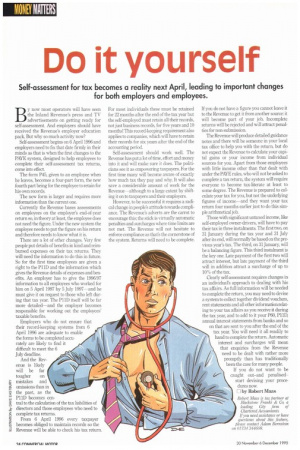Do it yourself
Page 26

If you've noticed an error in this article please click here to report it so we can fix it.
Self-assessment for tax becomes a reality next April, leading to important changes for both employers and employees.
By now most operators will have seen the Inland Revenue's press and TV advertisements on getting ready for self-assessment. And employers should have received the Revenue's employer education pack. But why so much activity now?
Self-assessment begins on 6 April 1996 and employers need to fix that date firmly in their minds as that is when the first changes to the PAYE system, designed to help employees to complete their self-assessment tax returns, come into effect The form P45, given to an employee when he leaves, becomes a four-part form, the new fourth part being for the employee to retain for his own records.
The new form is larger and requires more information than the current one.
Currently the Revenue bases assessments on employees on the employer's end-of-year return so, in theory at least, the employee does not need the figure. Under the new system the employee needs to put the figure on his return and therefore needs to know what it is.
There are a lot of other changes. Very few people put details of benefits in kind and reimbursed expenses on their tax returns. They will need the information to do this in future. So for the first time employees are given a right to the PhD and the information which gives the Revenue details of expenses and benefits. An employer has to give the 1996/97 information to all employees who worked for him on 5 April 1997 by 5 July 1997—and he must give it on request to those who left during that tax year. The PhD itself will be far more detailed—and the employer becomes responsible for working out the employees' taxable benefits.
Employers who do not ensure that their record-keeping systems from 6 April 1996 are adequate to enable the forms to be completed accurately are likely to find it difficult to meet the 6 July deadline.
And the Revenue is likely will be far tougher on 'mistakes and cc
F2 omissions than in the past, as the w
PhD becomes cen tral to the calculation of the tax liabilities of o
1directors and those employees who need to 6 complete tax returns.
a From 6 April 1996 every taxpayer becomes obliged to maintain records so the g Revenue will be able to check his tax return.
For most individuals these must be retained for 22 months after the end of the tax year but the self-employed must retain all their records, not just business records, for five years and 10 months! This record-keeping requirement also applies to companies, which will have to retain their records for six years after the end of the accounting period.
Self-assessment should work well. The Revenue has put a lot of time, effort and money into it and will make sure it does. The politicians see it as empowering taxpayers. For the first time many will become aware of exactly how much tax they pay and why It will also save a considerable amount of work for the Revenue—although to a large extent by shifting it on to taxpayers and their employers.
However, to be successful it requires a radical change in people's attitude towards compliance. The Revenue's adverts are the carrot to encourage this; the stick is virtually automatic penalties and surcharges where time limits are not met. The Revenue will not hesitate to enforce compliance as that's the cornerstone of the system. Returns will need to be complete. If you do not have a figure you cannot leave it to the Revenue to get it from another source: it will become part of your job. Incomplete returns will be rejected and will attract penalties for non-submission.
The Revenue will produce detailed guidance notes and there will be someone in your local tax office to help you with the return, but do not expect the Revenue to calculate your capital gains or your income from individual sources for you. Apart from those employees with little income other than that dealt with under the PAYE rules, who will not be asked to complete a tax return, the system will require everyone to become tax-literate at least to some degree. The Revenue is prepared to calculate your tax for you, but not the underlying figures of income—and they want your tax return four months earlier just to do this situple arithmetical job.
Those with significant untaxed income, like self-employed owner-drivers, will have to pay their tax in three instalments. The first two, on 31 January during the tax year and 31 July after its end, will normally be based on the previous year's tax. The third, on 31 January will be a balancing figure. This third instalment is the key one. Late payment of the first two will attract interest, but late payment of the third will in addition attract a surcharge of up to 10% of the tax.
Clearly self-assessment requires changes in an individual's approach to dealing with his tax affairs. As full information will be needed to complete the return, you may need to devise a system to collect together dividend vouchers, rent statements and all other information relating to your tax affairs as you receive it during the tax year, and to add to it your P60, PhD, annual interest statements from banks and so on that are sent to you after the end of the tax year. You will need it all readily to hand to complete the return. Automatic interest and surcharges will mean that enquiries from the Revenue need to be dealt with rather more promptly than has traditionally been the case for many people.
If you do not want to be caught out-and penalisedstart devising your procedures now.








































































































